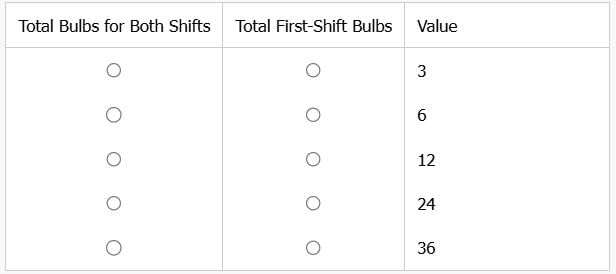GMAT Exam > GMAT Questions > At a certain factory, the number of first-shi...
Start Learning for Free
At a certain factory, the number of first-shift workers is 2/3 the number of second-shift workers. Every day, each second-shift worker can make 4/3 as many light bulbs as each first-shift worker.
In the first column, identify a possible number of total light bulbs made on one day by the two shifts combined; in the second column, identify the corresponding number of total light bulbs that the first-shift workers made on the same day. Make only two selections, one in each column.

In the first column, identify a possible number of total light bulbs made on one day by the two shifts combined; in the second column, identify the corresponding number of total light bulbs that the first-shift workers made on the same day. Make only two selections, one in each column.

- a)Total Bulbs for Both Shifts: 36
Total First-Shift Bulbs: 12 - b)Total Bulbs for Both Shifts: 3
Total First-Shift Bulbs: 6 - c)Total Bulbs for Both Shifts: 12
Total First-Shift Bulbs: 6 - d)Total Bulbs for Both Shifts: 12
Total First-Shift Bulbs: 24
Correct answer is option 'A'. Can you explain this answer?
Most Upvoted Answer
At a certain factory, the number of first-shift workers is 2/3 the num...
Let number of second shift workers be n
Then number of first shift workers = 2n/3
Let b the number of bulbs made by each worker in the first shift
Then number of bulbs made by each worker in the second shift is 4b/3
Total bulbs made by first shift workers: 2nb/3
Tota bulbs made by second shift workers: 4nb/3
Total bulbs by both: 6nb/3 => 2nb
Now try substituting value of 2nb (first column) to find nb and get 2nb/3 (second column)
If 2nb =3, nb. = 3/2 not possible => eliminate
If 2nb = 6, nb = 3 => 2/3 nb = 2 which is not present => eliminate
If 2nb = 12, nb = 6 => 2/3 nb = 4, again not present => eliminate
If 2nb = 24, nb = 12 => 2/3nb = 8, again not present => eliminate
Therefore only 36 should fit in. Let's check
2nb = 36 => nb = 18 => 2/3nb = 12
Hence Total Bulbs for Both Shifts (Column 1) = 36
Total First-Shift Bulbs (Column 2) = 12
Then number of first shift workers = 2n/3
Let b the number of bulbs made by each worker in the first shift
Then number of bulbs made by each worker in the second shift is 4b/3
Total bulbs made by first shift workers: 2nb/3
Tota bulbs made by second shift workers: 4nb/3
Total bulbs by both: 6nb/3 => 2nb
Now try substituting value of 2nb (first column) to find nb and get 2nb/3 (second column)
If 2nb =3, nb. = 3/2 not possible => eliminate
If 2nb = 6, nb = 3 => 2/3 nb = 2 which is not present => eliminate
If 2nb = 12, nb = 6 => 2/3 nb = 4, again not present => eliminate
If 2nb = 24, nb = 12 => 2/3nb = 8, again not present => eliminate
Therefore only 36 should fit in. Let's check
2nb = 36 => nb = 18 => 2/3nb = 12
Hence Total Bulbs for Both Shifts (Column 1) = 36
Total First-Shift Bulbs (Column 2) = 12

|
Explore Courses for GMAT exam
|

|
Question Description
At a certain factory, the number of first-shift workers is 2/3 the number of second-shift workers. Every day, each second-shift worker can make 4/3 as many light bulbs as each first-shift worker.In the first column, identify a possible number of total light bulbs made on one day by the two shifts combined; in the second column, identify the corresponding number of total light bulbs that the first-shift workers made on the same day. Make only two selections, one in each column.a)Total Bulbs forBoth Shifts: 36Total First-ShiftBulbs: 12b)Total Bulbs forBoth Shifts: 3Total First-ShiftBulbs: 6c)Total Bulbs forBoth Shifts: 12Total First-ShiftBulbs: 6d)Total Bulbs forBoth Shifts: 12Total First-ShiftBulbs: 24Correct answer is option 'A'. Can you explain this answer? for GMAT 2025 is part of GMAT preparation. The Question and answers have been prepared according to the GMAT exam syllabus. Information about At a certain factory, the number of first-shift workers is 2/3 the number of second-shift workers. Every day, each second-shift worker can make 4/3 as many light bulbs as each first-shift worker.In the first column, identify a possible number of total light bulbs made on one day by the two shifts combined; in the second column, identify the corresponding number of total light bulbs that the first-shift workers made on the same day. Make only two selections, one in each column.a)Total Bulbs forBoth Shifts: 36Total First-ShiftBulbs: 12b)Total Bulbs forBoth Shifts: 3Total First-ShiftBulbs: 6c)Total Bulbs forBoth Shifts: 12Total First-ShiftBulbs: 6d)Total Bulbs forBoth Shifts: 12Total First-ShiftBulbs: 24Correct answer is option 'A'. Can you explain this answer? covers all topics & solutions for GMAT 2025 Exam. Find important definitions, questions, meanings, examples, exercises and tests below for At a certain factory, the number of first-shift workers is 2/3 the number of second-shift workers. Every day, each second-shift worker can make 4/3 as many light bulbs as each first-shift worker.In the first column, identify a possible number of total light bulbs made on one day by the two shifts combined; in the second column, identify the corresponding number of total light bulbs that the first-shift workers made on the same day. Make only two selections, one in each column.a)Total Bulbs forBoth Shifts: 36Total First-ShiftBulbs: 12b)Total Bulbs forBoth Shifts: 3Total First-ShiftBulbs: 6c)Total Bulbs forBoth Shifts: 12Total First-ShiftBulbs: 6d)Total Bulbs forBoth Shifts: 12Total First-ShiftBulbs: 24Correct answer is option 'A'. Can you explain this answer?.
At a certain factory, the number of first-shift workers is 2/3 the number of second-shift workers. Every day, each second-shift worker can make 4/3 as many light bulbs as each first-shift worker.In the first column, identify a possible number of total light bulbs made on one day by the two shifts combined; in the second column, identify the corresponding number of total light bulbs that the first-shift workers made on the same day. Make only two selections, one in each column.a)Total Bulbs forBoth Shifts: 36Total First-ShiftBulbs: 12b)Total Bulbs forBoth Shifts: 3Total First-ShiftBulbs: 6c)Total Bulbs forBoth Shifts: 12Total First-ShiftBulbs: 6d)Total Bulbs forBoth Shifts: 12Total First-ShiftBulbs: 24Correct answer is option 'A'. Can you explain this answer? for GMAT 2025 is part of GMAT preparation. The Question and answers have been prepared according to the GMAT exam syllabus. Information about At a certain factory, the number of first-shift workers is 2/3 the number of second-shift workers. Every day, each second-shift worker can make 4/3 as many light bulbs as each first-shift worker.In the first column, identify a possible number of total light bulbs made on one day by the two shifts combined; in the second column, identify the corresponding number of total light bulbs that the first-shift workers made on the same day. Make only two selections, one in each column.a)Total Bulbs forBoth Shifts: 36Total First-ShiftBulbs: 12b)Total Bulbs forBoth Shifts: 3Total First-ShiftBulbs: 6c)Total Bulbs forBoth Shifts: 12Total First-ShiftBulbs: 6d)Total Bulbs forBoth Shifts: 12Total First-ShiftBulbs: 24Correct answer is option 'A'. Can you explain this answer? covers all topics & solutions for GMAT 2025 Exam. Find important definitions, questions, meanings, examples, exercises and tests below for At a certain factory, the number of first-shift workers is 2/3 the number of second-shift workers. Every day, each second-shift worker can make 4/3 as many light bulbs as each first-shift worker.In the first column, identify a possible number of total light bulbs made on one day by the two shifts combined; in the second column, identify the corresponding number of total light bulbs that the first-shift workers made on the same day. Make only two selections, one in each column.a)Total Bulbs forBoth Shifts: 36Total First-ShiftBulbs: 12b)Total Bulbs forBoth Shifts: 3Total First-ShiftBulbs: 6c)Total Bulbs forBoth Shifts: 12Total First-ShiftBulbs: 6d)Total Bulbs forBoth Shifts: 12Total First-ShiftBulbs: 24Correct answer is option 'A'. Can you explain this answer?.
Solutions for At a certain factory, the number of first-shift workers is 2/3 the number of second-shift workers. Every day, each second-shift worker can make 4/3 as many light bulbs as each first-shift worker.In the first column, identify a possible number of total light bulbs made on one day by the two shifts combined; in the second column, identify the corresponding number of total light bulbs that the first-shift workers made on the same day. Make only two selections, one in each column.a)Total Bulbs forBoth Shifts: 36Total First-ShiftBulbs: 12b)Total Bulbs forBoth Shifts: 3Total First-ShiftBulbs: 6c)Total Bulbs forBoth Shifts: 12Total First-ShiftBulbs: 6d)Total Bulbs forBoth Shifts: 12Total First-ShiftBulbs: 24Correct answer is option 'A'. Can you explain this answer? in English & in Hindi are available as part of our courses for GMAT.
Download more important topics, notes, lectures and mock test series for GMAT Exam by signing up for free.
Here you can find the meaning of At a certain factory, the number of first-shift workers is 2/3 the number of second-shift workers. Every day, each second-shift worker can make 4/3 as many light bulbs as each first-shift worker.In the first column, identify a possible number of total light bulbs made on one day by the two shifts combined; in the second column, identify the corresponding number of total light bulbs that the first-shift workers made on the same day. Make only two selections, one in each column.a)Total Bulbs forBoth Shifts: 36Total First-ShiftBulbs: 12b)Total Bulbs forBoth Shifts: 3Total First-ShiftBulbs: 6c)Total Bulbs forBoth Shifts: 12Total First-ShiftBulbs: 6d)Total Bulbs forBoth Shifts: 12Total First-ShiftBulbs: 24Correct answer is option 'A'. Can you explain this answer? defined & explained in the simplest way possible. Besides giving the explanation of
At a certain factory, the number of first-shift workers is 2/3 the number of second-shift workers. Every day, each second-shift worker can make 4/3 as many light bulbs as each first-shift worker.In the first column, identify a possible number of total light bulbs made on one day by the two shifts combined; in the second column, identify the corresponding number of total light bulbs that the first-shift workers made on the same day. Make only two selections, one in each column.a)Total Bulbs forBoth Shifts: 36Total First-ShiftBulbs: 12b)Total Bulbs forBoth Shifts: 3Total First-ShiftBulbs: 6c)Total Bulbs forBoth Shifts: 12Total First-ShiftBulbs: 6d)Total Bulbs forBoth Shifts: 12Total First-ShiftBulbs: 24Correct answer is option 'A'. Can you explain this answer?, a detailed solution for At a certain factory, the number of first-shift workers is 2/3 the number of second-shift workers. Every day, each second-shift worker can make 4/3 as many light bulbs as each first-shift worker.In the first column, identify a possible number of total light bulbs made on one day by the two shifts combined; in the second column, identify the corresponding number of total light bulbs that the first-shift workers made on the same day. Make only two selections, one in each column.a)Total Bulbs forBoth Shifts: 36Total First-ShiftBulbs: 12b)Total Bulbs forBoth Shifts: 3Total First-ShiftBulbs: 6c)Total Bulbs forBoth Shifts: 12Total First-ShiftBulbs: 6d)Total Bulbs forBoth Shifts: 12Total First-ShiftBulbs: 24Correct answer is option 'A'. Can you explain this answer? has been provided alongside types of At a certain factory, the number of first-shift workers is 2/3 the number of second-shift workers. Every day, each second-shift worker can make 4/3 as many light bulbs as each first-shift worker.In the first column, identify a possible number of total light bulbs made on one day by the two shifts combined; in the second column, identify the corresponding number of total light bulbs that the first-shift workers made on the same day. Make only two selections, one in each column.a)Total Bulbs forBoth Shifts: 36Total First-ShiftBulbs: 12b)Total Bulbs forBoth Shifts: 3Total First-ShiftBulbs: 6c)Total Bulbs forBoth Shifts: 12Total First-ShiftBulbs: 6d)Total Bulbs forBoth Shifts: 12Total First-ShiftBulbs: 24Correct answer is option 'A'. Can you explain this answer? theory, EduRev gives you an
ample number of questions to practice At a certain factory, the number of first-shift workers is 2/3 the number of second-shift workers. Every day, each second-shift worker can make 4/3 as many light bulbs as each first-shift worker.In the first column, identify a possible number of total light bulbs made on one day by the two shifts combined; in the second column, identify the corresponding number of total light bulbs that the first-shift workers made on the same day. Make only two selections, one in each column.a)Total Bulbs forBoth Shifts: 36Total First-ShiftBulbs: 12b)Total Bulbs forBoth Shifts: 3Total First-ShiftBulbs: 6c)Total Bulbs forBoth Shifts: 12Total First-ShiftBulbs: 6d)Total Bulbs forBoth Shifts: 12Total First-ShiftBulbs: 24Correct answer is option 'A'. Can you explain this answer? tests, examples and also practice GMAT tests.

|
Explore Courses for GMAT exam
|

|
Signup for Free!
Signup to see your scores go up within 7 days! Learn & Practice with 1000+ FREE Notes, Videos & Tests.


















